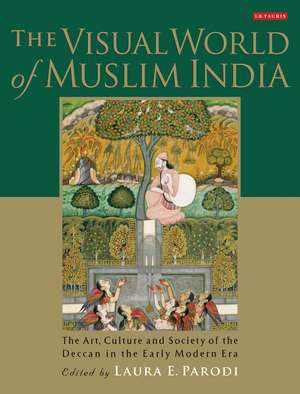The Visual World of Muslim India: The Art, Culture and Society of the Deccan in the Early Modern Era
Autor Laura E. Parodien Limba Engleză Hardback – 26 mai 2014
Preț: 793.78 lei
Preț vechi: 1124.66 lei
-29% Nou
Puncte Express: 1191
Preț estimativ în valută:
151.94€ • 165.09$ • 127.71£
151.94€ • 165.09$ • 127.71£
Carte tipărită la comandă
Livrare economică 21 aprilie-05 mai
Preluare comenzi: 021 569.72.76
Specificații
ISBN-13: 9781848857469
ISBN-10: 1848857462
Pagini: 400
Ilustrații: 137 Integrated colour and black and white images
Dimensiuni: 189 x 246 x 36 mm
Greutate: 1.63 kg
Ediția:New.
Editura: Bloomsbury Publishing
Colecția I.B.Tauris
Locul publicării:London, United Kingdom
ISBN-10: 1848857462
Pagini: 400
Ilustrații: 137 Integrated colour and black and white images
Dimensiuni: 189 x 246 x 36 mm
Greutate: 1.63 kg
Ediția:New.
Editura: Bloomsbury Publishing
Colecția I.B.Tauris
Locul publicării:London, United Kingdom
Notă biografică
Laura E. Parodi (Ph.D.) is an independent scholar based in Genoa, Italy. She has taught courses and seminars at the University of Oxford, University College Dublin, the Massachusetts Institute of Technology, and two Italian universities, and is the author of numerous essays on Mughal art and architecture, manuscript studies, and garden historiography.
Cuprins
Foreword - Richard M. EatonIntroduction: The Deccan as a Laboratory for the Study of Early Modern Visual CulturePART I: EXPLORING URBAN LANDSCAPES FROM THE FUNCTIONAL TO THE SYMBOLICThe Circular Cities of the Deccan - Marika SandarGolconda's Mosques and Tombs: Distribution, Chronology and Meaning - Robert A. SimpkinsRecreating Islam in the Seventeenth-Century Deccan - Mark BrandPART II: PEOPLE'S BELIEFS IN THE MIRROR OF ARCHITECTURE AND THE ARTSSculpted Representations of Muslims and Bahmani Architectural Influence at Vijayanagara - George MichellThe Great Mosque at Gulbarga Reinterpreted as the Hazar Sutun of Firuz Shah Bahmani - Helen PhilonDeccani Guns: Features and Ornamentalism - Klaus RötzerThe Fighting on the Wall: Animal Symbolism in the Deccan in a Eurasian Perspective - Gijs KruijtzerPART III: COURT ART POLIICIES: COSMOPOLITANISM, DIPLOMACY AND THE VISUALVariations on a Persian Theme: Persianate Painting at the Court of Golconda - Laura WeinsteinA Dutch Artist in Biajapur - Deborah Hutton and Rebecca TuckerVida de Jacques de Coutre: A Flemish Account of Bijapuri Visual Culture in the Shadow of Mughal Felicity - Keelan OvertonPART IV: BEYOND THE COURT: MARKET COMMODITIES AND POPULAR DEVOTION AS REFLECTED IN THE ARTSEast and West: The Deccan and the Outside World - John CarswellBidri Ware and the New Mughal Order - Laura ParodiGulshan-i 'Ishq: Illustrations of a Sufi Romance of the Deccan - Navina HaidarSacred Spaces and Objects of Popular Muslim Devotion, Practices and Festivals - Omar KhalidiConclusion




